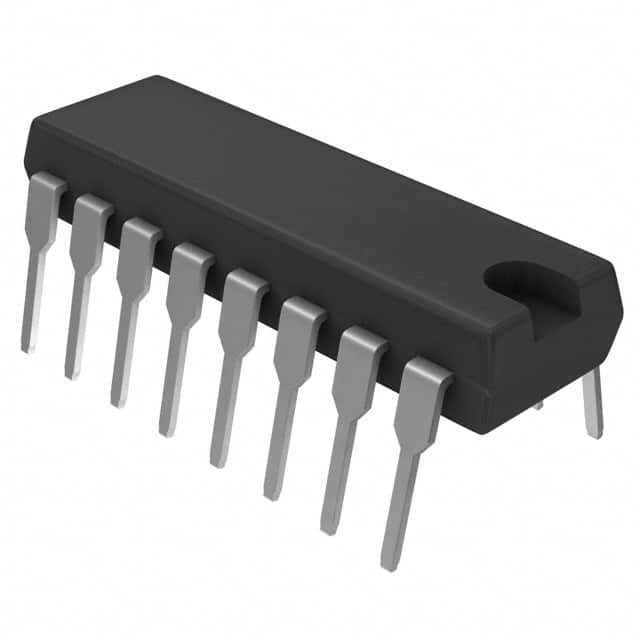Vedi le specifiche per i dettagli del prodotto.

M74HC4094B1R - English Editing Encyclopedia Entry
Product Overview
Category
The M74HC4094B1R belongs to the category of integrated circuits (ICs).
Use
This IC is commonly used for serial-in, parallel-out (SIPO) shift register applications.
Characteristics
- High-speed operation
- Wide supply voltage range
- Low power consumption
- Schmitt trigger inputs
- Buffered outputs
Package
The M74HC4094B1R is available in a 16-pin DIP (Dual Inline Package) format.
Essence
The essence of the M74HC4094B1R lies in its ability to convert serial data into parallel output, making it suitable for various digital applications.
Packaging/Quantity
The M74HC4094B1R is typically packaged in reels or tubes, with a quantity of 2500 units per reel/tube.
Specifications
- Supply Voltage: 2V to 6V
- Input Voltage: -0.5V to VCC + 0.5V
- Output Voltage: 0V to VCC
- Operating Temperature Range: -40°C to 125°C
- Maximum Clock Frequency: 25 MHz
Detailed Pin Configuration
The M74HC4094B1R has a total of 16 pins, each serving a specific function:
- Serial Data Input (DS)
- Serial Data Output (QH')
- Clock Input (CP)
- Master Reset Input (MR)
- Output Enable Input (OE)
- Parallel Data Inputs (QA-QH)
- Storage Register Clock Input (SHCP)
- Shift Register Clock Input (STCP)
- Serial Data Input (DS)
- Serial Data Output (QH')
- Clock Input (CP)
- Master Reset Input (MR)
- Output Enable Input (OE)
- Parallel Data Inputs (QA-QH)
- Storage Register Clock Input (SHCP)
- Shift Register Clock Input (STCP)
Functional Features
The M74HC4094B1R offers the following functional features:
- Serial-to-parallel data conversion
- Cascadable for larger shift register applications
- Schmitt trigger inputs for noise immunity
- Buffered outputs for driving external loads
- Master reset functionality for clearing the shift register
- Output enable control for power-saving operation
Advantages and Disadvantages
Advantages
- High-speed operation allows for efficient data transfer
- Wide supply voltage range enables compatibility with various systems
- Low power consumption reduces energy requirements
- Schmitt trigger inputs provide robustness against noise
- Buffered outputs can drive external loads effectively
Disadvantages
- Limited maximum clock frequency of 25 MHz may restrict certain high-speed applications
- Availability in a specific package format (16-pin DIP) may not suit all design requirements
Working Principles
The M74HC4094B1R operates based on the principle of serial-in, parallel-out (SIPO) shift registers. It receives serial data through the DS pin and shifts it into an internal shift register upon each clock pulse at the CP input. The parallel data is then available at the QA-QH outputs. The storage register clock (SHCP) and shift register clock (STCP) inputs control the transfer of data between the shift register and the storage register.
Detailed Application Field Plans
The M74HC4094B1R finds application in various digital systems, including but not limited to: - LED matrix displays - Multiplexed seven-segment displays - Data acquisition systems - Serial data communication interfaces - Address decoding circuits - Control signal generation circuits
Detailed and Complete Alternative Models
- 74HC4094: This is a similar IC from the 74HC series, offering comparable functionality.
- CD4094: An alternative IC from the CD4000 series, providing similar serial-in, parallel-out shift register capabilities.
These alternative models can be considered based on specific design requirements and availability.
Word count: 529 words
10 domande e risposte comuni relative all'applicazione di M74HC4094B1R nelle soluzioni tecniche
Sure! Here are 10 common questions and answers related to the application of M74HC4094B1R in technical solutions:
Q1: What is the M74HC4094B1R? A1: The M74HC4094B1R is a high-speed CMOS 8-bit shift register with output latches. It can be used for various applications such as data storage, LED control, and digital signal processing.
Q2: What is the maximum clock frequency of the M74HC4094B1R? A2: The maximum clock frequency of the M74HC4094B1R is typically 25 MHz.
Q3: How many outputs does the M74HC4094B1R have? A3: The M74HC4094B1R has 8 outputs that can be individually controlled.
Q4: Can the M74HC4094B1R be cascaded to increase the number of outputs? A4: Yes, multiple M74HC4094B1R chips can be cascaded together to increase the number of outputs.
Q5: What is the power supply voltage range for the M74HC4094B1R? A5: The power supply voltage range for the M74HC4094B1R is typically between 2V and 6V.
Q6: Does the M74HC4094B1R have built-in protection features? A6: Yes, the M74HC4094B1R has built-in protection against electrostatic discharge (ESD) and excessive current.
Q7: Can the M74HC4094B1R be used with both TTL and CMOS logic levels? A7: Yes, the M74HC4094B1R is compatible with both TTL and CMOS logic levels.
Q8: What is the maximum output current of the M74HC4094B1R? A8: The maximum output current of the M74HC4094B1R is typically 6 mA.
Q9: Does the M74HC4094B1R have a power-down mode? A9: No, the M74HC4094B1R does not have a power-down mode. It operates continuously when powered.
Q10: Can the M74HC4094B1R be used in automotive applications? A10: Yes, the M74HC4094B1R is suitable for automotive applications as it meets the requirements for automotive temperature range and reliability standards.
Please note that these answers are general and may vary depending on the specific datasheet and manufacturer's specifications for the M74HC4094B1R.

